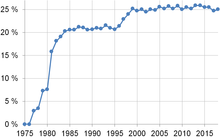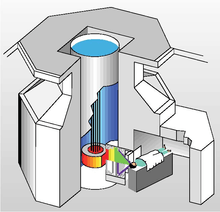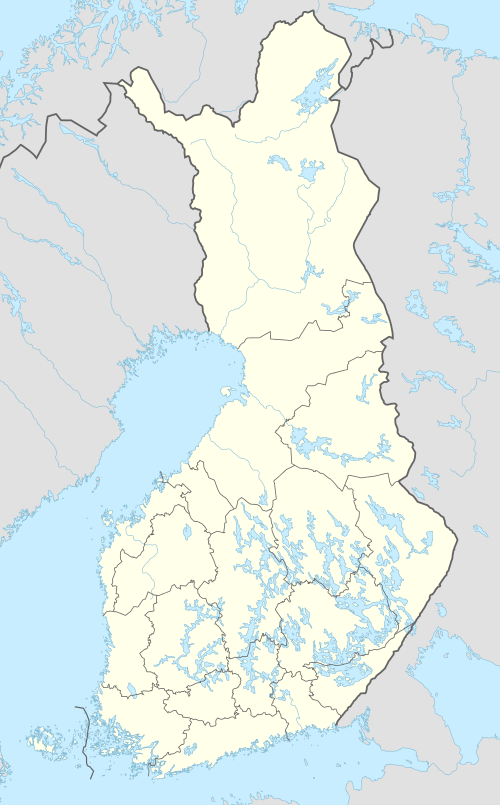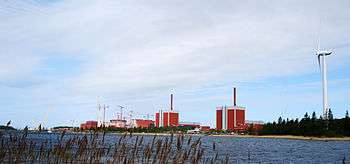Nuclear power in Finland
As of 2019, Finland has four nuclear reactors in two power plants, all located on the shores of the Baltic Sea, and providing about 30% of the country's electricity. The first reactor came into operation in 1977.[1] A fifth reactor is under construction, scheduled to begin commercial operation in March 2021, and a sixth reactor is planned.[2] If all planned projects are completed, the share of electricity produced by nuclear could double, reaching around 60%.[1]
Finland's nuclear reactors are among the world's most productive, with an average capacity factor of 95% in the 2010s.[1]
Operational power plants
Reactors

| Site | Unit | Reactor type | Net electric power[3] | Supplier | Start-up[3] |
|---|---|---|---|---|---|
| Loviisa Nuclear Power Plant | LO1 | VVER (Pressurized water reactor) | 507 MW | Atomenergoexport | 1977 |
| LO2 | VVER (Pressurized water reactor) | 507 MW | Atomenergoexport | 1980 | |
| Olkiluoto Nuclear Power Plant | OL1 | Boiling water reactor | 890 MW | ASEA-Atom | 1978 |
| OL2 | Boiling water reactor | 890 MW | ASEA-Atom | 1980 |
Loviisa plant
Located in Loviisa, on the south coast (Gulf of Finland), the plant comprises two VVER-440 pressurized water reactors built by Soviet Atomenergoexport[3], but fitted with Western instrumentation, containment structures and control systems[4]. The plant is owned and operated by Fortum. Electrical production started in 1977 and 1980, with the reactors now producing 507 MWe each.[3] On 26 July 2007 new licenses were granted to Fortum to operate the units until 2027 and 2030, conditional on safety reviews before 2015 and 2023.[4]
Olkiluoto plant
The Olkiluoto plant is owned by Teollisuuden Voima (TVO), and is located in Eurajoki, on the west coast, near Rauma. It has two boiling water reactors currently producing 890 MWe each. They were built by the Swedish company Asea-Atom (nowadays ABB Group), and went online in 1978 and 1980.[3]
Areva is building a third reactor at the Olkiluoto site for a fixed price of €3.2 billion ($3.6 billion). It will be a European Pressurized Reactor (EPR), and will have a power output of 1,600 MWe.[1] The reactor was originally scheduled to start production in 2009, but has been delayed by 12 years. As of December 2019, the start of commercial operation is expected for March 2021.[2] Total costs now exceed 8.5 billion euros, and plans for a possible fourth plant has been discarded.[5]
Otaniemi research reactor, FiR 1

FiR 1 was a small research reactor located in Otaniemi, Espoo; a TRIGA Mark II, built for the Helsinki University of Technology in 1962. Owned by the VTT Technical Research Centre of Finland since 1971, it had a power output of 250 kW. It was mainly used in boron neutron capture therapy and research. The reactor was permanently shut down on 30 July 2015. The reactor will be dismantled in 2019–2022. The spent fuel is intended to be returned to the United States.[6]
Regulation and safety
Under the Nuclear Energy Act 1987 the Ministry of Economic Affairs and Employment (Finnish: Työ- ja elinkeinoministeriö, TEM) is responsible for supervision of nuclear power operation and for waste disposal.[1]
The Radiation and Nuclear Safety Authority (Finnish: Säteilyturvakeskus, STUK) is responsible for regulation and inspection. It operates under the Council of State (effectively the government), which licenses major nuclear facilities. STUK is under the Ministry of Social Affairs and Health, and is assisted by an Advisory Committee on Nuclear Safety in major matters.[1]
Licensing of new reactors
Licensing of a new nuclear power plant in Finland involves four main steps. First the license applicant has to draw up an environmental impact assessment. In the second phase the applicant applies for a decision in principle. The decision is made by the Finnish government, after which the parliament votes on ratifying it. In this phase the city council of the municipality has a veto right, and it can stop the project. The third step is the construction license, and the fourth step is the operating license. These licenses are decided by the government, but a statement on safety is issued by STUK, and STUK has a veto right on the licenses.[7] The operating license is always granted for a definite duration. STUK may interrupt the operation of a nuclear power plant if so required in order to ensure safety.[8]
New construction
Reactors
| Site | Unit | Reactor type | Power generation | Constructor | Commission date |
|---|---|---|---|---|---|
| Olkiluoto Nuclear Power Plant | OL3 | EPR (Pressurized water reactor) | 1600 MW | Areva-Siemens | 2021 |
| Hanhikivi Nuclear Power Plant | 1 | VVER (Pressurized water reactor) | 1200 MW | Fennovoima | 2028 |
Fifth reactor
A cabinet decision in 2002 to allow the construction of a fifth nuclear reactor was accepted in parliament. The Green League, which was principally opposed to the expansion of nuclear power and which held the position of the Minister of Environment, left the coalition government on 31 May 2002 in protest of the cabinet's decision, narrowing the majority of the coalition in the parliament.[9] Economic, energy security and environmental grounds were given as reasons to build the fifth reactor. While hydroelectricity is curtailed in dry years (range 9,455–14,865 GWh 1990–2006 [10]), nuclear energy supplies near-constant amounts of energy, and studies showed that nuclear energy was the cheapest option for Finland. The vote was seen as very significant for nuclear energy policy in that it was the first decision to build a new nuclear power plant in western Europe for more than a decade.
Teollisuuden Voima (TVO) ordered the 1600 MW nuclear reactor (Olkiluoto 3) in 2003. The suppliers were the French company Areva NP (formerly Framatome) and the German company Siemens, which owned 34% of Areva NP. The price was fixed at €3.2 billion and completion was scheduled for 2009.[1] The construction of this plant is now substantially behind schedule and over cost. As of 2010, Areva expected to lose €2.3 billion ($3.2 billion) on the project.[11] As of December 2019, the expected start of commercial operation is in March 2021.[2]
According to World Nuclear Association 2008: ”Experience has shown that each year of additional delay in the construction of a nuclear power plants adds another estimated $1 billion to the cost”.[12]
Siemens sold its share of Areva NP to Areva in January 2009 for €2.1 billion.[13] In June 2010, the European Union began an investigation of Areva and Siemens for anti-trust violations in nuclear cooperation.[14] The European Commission lists the publications related to the case.
Sixth reactor
On 21 April 2010, the Government of Finland decided to grant permits for construction of the sixth and seventh commercial reactors to Teollisuuden Voima and Fennovoima, a joint venture between RAOS Voima Oy, a subsidiary of Rusatom, and SF energy, a consortium of Finnish industrial companies. The application by Fortum to build a new reactor at Loviisa was declined.[15] The Finnish Parliament approved the building permits on 1 July 2010.[16][17][18]
As in 2002, the Green League was principally opposed to nuclear power and represented in the coalition government, holding the positions of the Minister of Justice and the Minister of Labour. This time the party had publicly stated before the 2007 parliamentary elections that it would not leave a coalition it had agreed to join, even if the other parties in that coalition decided to license further reactors. The party viewed the 2002 decision to expand nuclear power with several new reactors as the principal one, and the 2010 decision as simply a question of which operators to grant the permits to. The Green League voted against all new permits in the cabinet, and lost the vote.
In October 2011, Fennovoima announced that it had chosen Pyhäjoki, in northern Finland, as the site for the country's third nuclear power plant. Construction was expected to start in 2018, but as of December 2018 has been delayed at least until 2021. The plant will not be operational before 2028, 4 years behind schedule.[19][20][21]
On 25 September 2014 after TVO's repeated delays in building the third reactor and its failure to begin work on the fourth reactor in time, the government refused TVO's application for a further extension to the permit for the fourth reactor. For not seeking building permission by June 2015 for the fourth Olkiluoto reactor, TVO's permit granted in 2010 is terminated.[22]
According to Taloustutkimus support of Fennovoima nuclear power was 26% among Finnish citizens in March 2017.[23]
Nuclear fuel
In 2009, Finland imported nuclear fuel from Sweden (40%), Russia (18%), Germany (2%) and other countries (40%).[24] In 2006 the other country source of nuclear fuel was Spain.[25]
Talvivaara Mining Company applied for uranium mining permission on 20 April 2010.[26] This was the first uranium application in the history of Finland. According to the Ministry of Trade, the EIA process on the application would run until 31 March 2011. However, on 31 March, the application was supplemented.[26] In February 2011, Talvivaara sold its uranium mining rights through 2027 to the Canadian company Cameco.[27]
Nuclear waste
Spent fuel from the Loviisa Nuclear Power Plant was initially shipped to the Soviet Union for reprocessing. After news of the 1957 Kyshtym disaster at the Mayak nuclear fuel reprocessing plant was made public in 1976, this option was no longer seen as politically acceptable. The Finnish Nuclear Energy Act was amended in 1994 so that all nuclear waste produced in Finland must be disposed of in Finland.[28] All spent fuel will be permanently buried in bedrock.
The Onkalo spent nuclear fuel repository at Olkiluoto was selected in 2000 to become the world's first deep geological repository of spent nuclear fuel. It will store the spent fuel from the plants owned by the utilities Fortum and TVO, that is, from the Loviisa and Olkiluoto sites. A documentary film about the waste repository has been made: Into Eternity.
Political issues
The major parliamentary political parties in Finland consider support or opposition to nuclear power as an issue that is left to each individual MP to decide.The National Coalition, the Finns Party, the Centre Party and the Social Democrats has included a supportive stance in their party platform.[29][30][31][32][33] The Green League, the Left Alliance and the Swedish People's Party explicitly oppose nuclear power in their platform, as well as most of the small parliamentary parties. The Christian Democrats however has not expressed a view.
The Finnish public is among the most nuclear power-friendly nations in the EU: in a 2008 survey, the production of nuclear electricity was supported by 61%, clearly above the EU average of 44%.[34]
Finnish energy industry association Finnish Energy has followed the public opinion yearly on their part. According to their data the public opinion towards the nuclear energy has slowly but steadily grown more positive all the way from the 1980s.[35] Two latest polls from December 2017 showed support for both nuclear power in Finland in general, as well as strong local support for the Fennovoima Hanhikivi plant. 37% of the respondents supported and 29% opposed additional construction of nuclear power to the country.[36][37]
References and notes
- "Nuclear Power in Finland". World Nuclear Association. Retrieved 2 January 2020.
- "Olkiluoto 3 reactor delayed yet again, now 12 years behind schedule". Yle Uutiset. 2019-12-20. Retrieved 2020-01-02.
- "Nuclear power plants in Finland". STUK. Retrieved 24 January 2020.
- "Twenty more years for Loviisa plant". World Nuclear News. July 27, 2007. Retrieved 2009-01-05.
- http://www.theecologist.org/News/news_analysis/2859924/finland_cancels_olkiluoto_4_nuclear_reactor_is_the_epr_finished.html
- "Decommissioning of FiR 1 nuclear reactor". VTT Technical Research Centre of Finland. 2019. Retrieved 2019-03-17.
- "STUK participates in the licensing of nuclear facilities". STUK. Retrieved 26 January 2020.
- "Operating licence". STUK. Retrieved 26 January 2020.
- "Vihreät jättävät hallituksen". Retrieved 6 May 2015.
- "Finland Hydroelectric Power Production by Year". Retrieved 6 May 2015.
- Helsingin Sanomat 8.6.2010
- Al Gore. Our Choice, A plan to solve the climate crises, Bloomsbury 2009, page 156
- Siemens luopuu yhteisyrityksestä Arevan kanssa, Siemensin uusi ydinvoimalakumppani tulossa Venäjältä, Helsingin Sanomat 27.1.2009 B4
- Helsingin Sanomat 3.6.2010 B9
- "Finnish government says yes to TVO and Fennovoima". Nuclear Engineering International. Global Trade Media. 2010-04-21. Archived from the original on 2011-06-13. Retrieved 2010-07-01.
- Kinnunen, Terhi (2010-07-01). "Finnish parliament agrees plans for two reactors". Reuters. Retrieved 2010-07-02.
- "Finnish nuclear program gets ready". World Nuclear News. 1 July 2010. Retrieved 2010-07-01.
- "Finland's parliament approves two new nuclear reactors". BBC News. Retrieved 6 May 2015.
- Kinnunen, Terhi (2011-10-05). "Finland names 1st nuclear site after Fukushima". Reuters. Retrieved 2011-10-05.
- "Fennovoima nuclear power plant delayed four years to 2028". YLE News. December 23, 2018. Retrieved January 1, 2019.
- "Finnland gibt Rosatom grünes Licht für Bau von AKW Hanhikivi (german)". Retrieved 2015-05-18.
- "TVO to miss Olkiluoto 4 licence application deadline". Retrieved 18 May 2015.
- Kyselytutkimus – Fennovoiman kannatus pudonnut entisestään. Vain 26% myöntäisi rakentamisluvan Lehdistötiedote - maaliskuu 15, 2017
- Table 5.3: Energy imports and value by country of origin in 2008
- Energy statistics in Finland, table 10.3 Energy Imports by Country of Origin 2006
- TEM Uraanintuotanto Talvivaarasta
- Lupahakemuksen täydennys, Talvivaara Sotkamo Oy, 31.3.2011
- "Nuclear Energy Act (990/1987) (eng.)" (PDF). Finlex.
- http://www.kokoomus.fi/mp/db/file_library/x/IMG/26558/file/Energia-jailmastopoliittinenkannanottoluonnoswww.doc Energia- ja ilmastopoliittinen kannanotto, Kansallinen Kokoomus 2006
- "Program for the 2011 election". Archived from the original on 28 September 2013. Retrieved 12 June 2014.
- "Perussuomalaiset alkaneet kääntyä ydinvoiman kannalle - Kotimaa - Turun Sanomat". Ts.fi. Retrieved 2014-06-12.
- http://www.keskusta.fi/includes/loader.aspx?id=6b6636d7-f713-410e-8f58-acd1b84fb928 Keskustan tavoitteet vaalikaudelle 2007–2011
- "Values A-Z". Sosialidemokraatit. Retrieved 2019-12-10.
- Tuohinen Petteri: Ydinvoiman kannatus on kasvanut EU:ssa. Ydinvoiman kannatus on kasvanut kolmessa vuodessa merkittävästi Euroopan unionin jäsenmaissa, selviää EU-komission julkaisemasta tuoreesta mielipidekyselystä. Helsingin Sanomat 5.7.2008
- "Development of the acceptance of nuclear power 1983 - 2015" (PDF). Finnish Energy. April 4, 2016. Retrieved 20 May 2018.
- Rytky, Tiina (February 8, 2018). "People's opinions matter - Public Acceptance Towards Nuclear Power is Increasing in Finland". Fennovoima Oy. Retrieved 20 May 2018.
- Energia-asenteet 2017 (PDF) (in Finnish). Finnish Energy. p. 23. Retrieved 20 May 2018.
External links
- "Nuclear Power in Finland". Country Briefings. World Nuclear Association. February 2009. Retrieved 2009-03-13.
- "Finland". Nuclear Energy Agency (NEA). June 20, 2007. Retrieved 2009-01-05.


